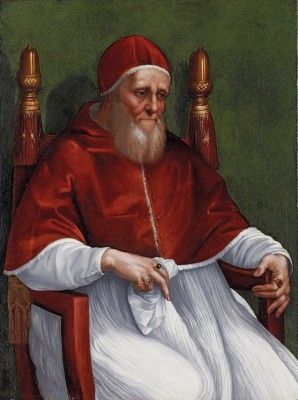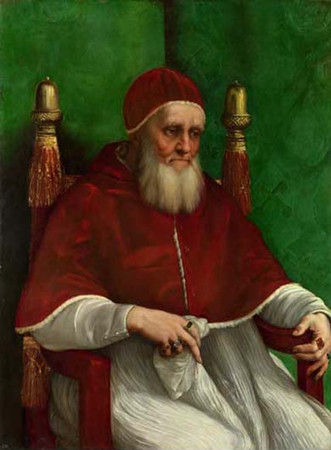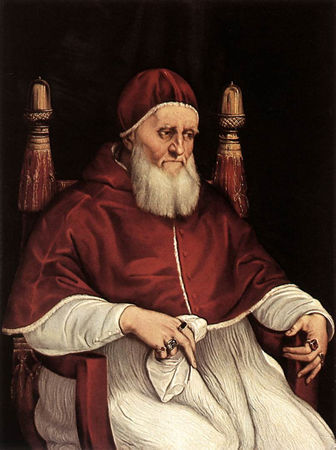Städel Museum purchases portrait of Pope Julius II, one of Raphael's most famous works
Raphael and workshop (1483–1520) - Portrait of Pope Julius II, 1511 / 12(2.3MB). Städel Museum
Frankfurt am Main. The portrait of Pope Julius II is one of Raphael’s most famous works. It was in Rome between June 1511 and March 1512 that the artist executed his likeness of this highly art-minded – but also extremely strong-willed and irascible – pope. It shows the bearded pope in a three-quarter view, life-size, sitting in an armchair. The portrait has come down to us in several versions, of which the most well-known is in the holdings of the National Gallery in London, and another is in those of the Uffizi in Florence. The Städel Museum quite recently succeeded in acquiring a hitherto unknown version of the portrait of Pope Julius II by Raphael and his workshop.
Measuring 106 by 78.4 cm and painted on a poplar panel, the work has been comprehensively examined and analyzed by art-historical as well as technological methods, and old retouchings and layers of varnish have been removed. The likeness is captivating not only by virtue of its artistic quality, but – unlike the versions in London and Florence – exhibits a series of creative changes carried out in the course of its execution. The underlying drawing made visible with the aid of infrared reflectography reveals that revisions were made above all in the area of the face and the position of the chair. As is documented by the x-ray image, the pose of the right hand was also altered during the painting process. These interventions and the special character of the underdrawings testify to an exceedingly creative approach to pictorial invention which lends this work a special status in comparison to the better-known portraits of Julius.
The painting’s provenance can be traced without interruption back to 1905, when it was auctioned off at the Hôtel Drouot in Paris as part of the Bercioux collection. Via various private owners, it then made its way from Paris to New York by 1909, and returned to Europe in 1914. In 2007, following further changes of ownership, it was offered at the Dorotheum in Vienna as a work by an imitator of Raphael. There it was purchased by the private Ellermann collection, from which the Städel had the fortune of purchasing it at a price substantially below market value thanks to the good will of the seller. The conjectured provenance of the painting before this thread is taken up in 1905 leads back to the family of Julius II himself.
Precisely that pre-1905 provenance – and above all the work’s comparison with the well-known versions of the portrait in London and Florence – will be the subject of an exhibition entitled "Raphael and the Portrait of Julius II: Pictorial Propaganda of a Renaissance Pope", to take place at the Städel from November 2012 to February 2013.
Starting on 15 December 2011, following a fourteen-month period in which the museum was closed for refurbishment, the painting of Julius II will be placed on view at the Städel for the first time within the framework of the re-opened and newly designed presentation of the "Old Masters" collection.
"We consider ourselves extraordinarily fortunate", says Max Hollein, Städel Museum director, "to have secured such a superb High Renaissance work for our Old Masters’ collection. For a museum with a nearly two-hundred-year-old tradition of research on Raphael and a collection of prints and drawings encompassing important works by this artist, the new acquisition is of very special significance."
"The Julius portrait further enhances the magnificent series of Renaissance and Mannerist portraits at the Städel. The procurement of a work providing such exciting insights into the creative process carried out by Raphael and his workshop is an exceptional stroke of luck", comments Prof Dr Jochen Sander, head of the "Old Masters" Department.
Pope Julius II
Giuliano della Rovere (b. in Albisola Superiore near Savona, Liguria on 5 December 1443; d. in Rome on 21 February 1513), who mounted the throne of St Peter as Pope Julius II in 1503, possessed a more profound understanding of art than virtually any head of the Roman Catholic Church. He commissioned Bramante to build the new St Peter’s, and Michelangelo to decorate the Sistine Chapel ceiling and create his tomb. And finally, he employed the twenty-five-year-old Raphael (b. in Urbino on 6 April or 28 March 1483; d. in Rome on 6 April 1520), who came to Rome in 1508, to decorate the Stanza, his residential and reception rooms in the Vatican Palace. In 1509, while this work was in progress, the pope left Rome to conduct war in Northern Italy at the head of the papal troops. Yet Julius’s personal participation in the military expedition did not lead to the desired success. The intervention of the French under Louis XII led to a crushing defeat, and the pope moreover contracted a life-threatening illness in the autumn of 1510. He apparently begged for divine assistance for his return to health and the restoration of the papal claim to supremacy over Northern Italy, and made a pledge in return: from October 1510 onwards, he grew a beard which he did not remove again until the French troops had been expelled from the territories of the Papal States in April 1512.
Raphael and workshop (1483–1520) - Portrait of Pope Julius II, 1511 / 12(2.3MB). Städel Museum
Raphael’s New Papal Portrait Type
On 27 June 1511, Julius returned to the Eternal City – with a full beard. In the course of the nine months that followed, he had himself portrayed by Raphael, whose likeness of Julius was to be one of his most influential works. There is not a single papal portrait up to and including those of the present pope, nor a single likeness of a high church dignitary that has not taken Raphael’s Julius as a model and an orientation. Raphael depicted the pope life-size, in a three-quarter view, sitting on an armchair in front of a green curtain. The subject’s body is turned slightly towards the right, and it is likewise to the right that he directs his gaze of concentration. However immersed in thought he may appear, however, his unbroken energy is betrayed not least of all by the firm grip of his left hand – studded with precious rings – around the armrest. Over a white rochet that is a sign of his episcopal office, the pope wears a mozzetta and camauro – a short hooded cape covering only his shoulders, and a tight-fitting cap. Made of crimson velvet and trimmed with ermine, these two articles of dress make unambiguous allusion to Julius’s claim to imperial power. Even the white cloth he holds in his right hand may well be a deliberate reference to that used by the emperors of antiquity to signal the opening of the games at the Circus Maximus in Rome. The magnificent combination of red, white and green is complemented by the brown and gold of the papal throne whose finials are crowned by two golden acorns. The fruit of the oak tree – his family’s heraldic symbol – served as an omnipresent emblem of the della Rovere pope.
Raphael and workshop (1483–1520) - Portrait of Pope Julius II, 1511/12 (infrared reflectography)(1.9MB). Städel Museum
The Underdrawing and Meticulous Composition Process of the Städel’s Julius Portrait
The version of the portrait of Julius II acquired by the Städel is captivating by virtue of its outstanding artistic quality. However, it also possesses another exceptional feature, and one which distinguishes it from the two versions known to date – those belonging to the National Gallery in London and the Uffizi in Florence. It exhibits extensive creative changes which were carried out in the course of the painting’s execution and can be made visible with the aid of such technologies as infrared reflectography and x-ray. The exceedingly free underdrawing, for example, executed with a brush as a preliminary stage in the work’s composition, shows the armchair in a position slightly different from that of the final solution. The acorns decorating the finials and alluding to the family crest of the della Rovere pope are entirely absent from the initial pictorial conception. Even the underdrawing of the pope’s face differs in important respects from the painted version, for instance in the rendering of the nose as well as the mouth, whose corners were drawn down much further in the underdrawing than in the finished product. Yet whereas the above-described areas were already corrected at the start of the painting process, the artist evidently did not arrive at the final position of the pope’s right hand until that process was well underway. For according to the x-ray image, it was apparently first raised in front of his body in a gesture of blessing. It will thus initially have corresponded to the portrait appearing in the frescoes executed by Raphael in the Stanza della Segnatura in the same period, and casting the della Rovere pope in the role of Gregory IX presenting the decretals.
"All of these observations", explains Prof Dr Jochen Sander, "assign the Städel work a key position within the process of this important compositional invention, in which Raphael himself and presumably also his workshop were involved." The precision and rigour applied to the execution of the pope’s exceedingly lifelike facial features and hands contrast conspicuously with the simple rendering of the rochet – the white garment – and the background. What is more, the meticulousness with which the pope’s rings were "staged", as it were, far surpasses their rather perfunctory treatment in the other two known versions. The employment of real gold for the elaborate representation of the rings’ settings and the fine fringes of the armchair decorations likewise points as much to the exceptional artistic standards cultivated by the painting’s author as to the fastidious expectations of his client.
Raffael and workshop (1483–1520) - Portrait of Pope Julius II, 1511/12 (infrared reflectography, detail)(1.6MB). Städel Museum
Technological Investigation and Cleaning
The painting has been comprehensively examined to determine the materials and techniques employed in its execution, as well as to assess its present condition. The methods encompassed systematic stereomicroscopic analyses and ranged from x-ray to infrared reflectography, UV fluorescence investigation to false-colour infrared reflectography, and macrophotographic documentation to the x-ray fluorescence analysis. Samples were taken and analysed to determine the composition of the layers of primer and paint, and the wooden panel was also subjected to biological examined. (Since the wood of the panel is poplar, no dendrochronological dating was possible.) Like the aforementioned insights into the development of the pictorial idea and the painting’s production process, all of the technological investigations point unequivocally to its execution in an Italian artist’s workshop of the early sixteenth century.
The painting was cleaned by Stephan Knobloch, the head of the Department of Painting Restoration, in the Städel Museum’s restoration workshop. All non-original layers of varnish were removed, along with retouchings and overpaintings which had become discoloured over time. After cleaning, the missing areas were filled in. According to Stephan Knobloch, "considering its age, the painting was in an excellent state, and the restoration work was accordingly limited more or less to the cleaning and the removal of later overpaintings and minor retouchings. Particularly the layers of paint forming the pope’s face survived in splendid condition."
Provenance
The painting’s provenance can be traced without interruption back to 1905. On 29 March of that year it was auctioned off at the Hôtel Drouot in Paris as part of the Bercioux collection. The buyer was the son (?) of the collector, Eugène Bercioux, a maker of and dealer in musical instruments who also operated a business in New York under the name of Eugene Burceaux. By 1909 at the latest, Bercioux/Burceaux gave the painting to George Essigke (d. 29 Mai 1909), the conductor of the West Point Military Academy band, as a security for a loan. Essigke’s wife and heiress, Hedwig Essigke, née Reil (d. 1934) had the work restored in 1909/10 by the artist and painting conservator Arthur Dawson of New York, who purchased it soon thereafter and published it as a Raphael original (New York Times, 15 May 1910). At some time before 1914, Dawson sold it to a hitherto unidentified American collector. Shortly before August 1914 the latter sent the painting to Europe so as to be able to compare it to the versions of the portrait in the Uffizi and the Palazzo Pitti in Florence. Owing to the outbreak of World War I, the work remained in Europe in the possession of the family of said collector, who died before the war ended, and in 1918 at the earliest was donated by that family to the American Vienna Relief Company in Vienna. On 1 January 1924, the American Committee for Vienna Relief of Chicago, a subsidiary of the American Vienna Relief Company of Vienna, sold it to the Viennese banker, entrepreneur and writer Richard Kola (1872–1939), whose heirs had it auctioned off at the Dorotheum in Vienna on 19 June 2007. There it was purchased by the Ellermann collection, from which the Städel Museum acquired it in 2010.
The portrait’s conjectured pre-1905 provenance leads back to the family of its subject. The work purchased by the Städel is presumably identical with the likeness sold at the auction "Tableaux des maîtres des écoles italienne, espagnole, flamande et allemande" in Paris, Me. Laneuville, fils, Me. Lacoste, on 29 March 1826. Johann David Passavant evaluated the work as a good copy after Raphael (Kunst-Blatt 1826, p. 203) and claimed that it had come from the Altamira collection in Spain, which had inherited it from the dukes of Moncada. The Moncada had been viceroys of Naples in the early sixteenth century and multiply associated with the della Rovere by marriage.
Raphaël (1511-1512), Pope Julius II. Huile sur bois, 108 x 80,7? National Gallery, London
Raphaël (1511-1512), Pope Julius II, tempera sur bois, 108,5 x 80. Galleria degli Uffizi, Florence

/https%3A%2F%2Fprofilepics.canalblog.com%2Fprofilepics%2F1%2F0%2F100183.jpg)
/https%3A%2F%2Fstorage.canalblog.com%2F03%2F02%2F119589%2F96711876_o.jpg)
/https%3A%2F%2Fstorage.canalblog.com%2F11%2F31%2F119589%2F94773502_o.jpg)
/https%3A%2F%2Fstorage.canalblog.com%2F20%2F83%2F119589%2F94772815_o.jpg)
/https%3A%2F%2Fstorage.canalblog.com%2F26%2F72%2F119589%2F75604929_o.jpg)
/https%3A%2F%2Fstorage.canalblog.com%2F59%2F60%2F119589%2F26458628_o.jpg)








/http%3A%2F%2Fstorage.canalblog.com%2F23%2F48%2F119589%2F122509465_o.jpg)
/http%3A%2F%2Fstorage.canalblog.com%2F19%2F64%2F119589%2F121786201_o.jpg)
/http%3A%2F%2Fstorage.canalblog.com%2F94%2F05%2F119589%2F117582005_o.jpg)
/http%3A%2F%2Fstorage.canalblog.com%2F07%2F41%2F119589%2F112792921_o.jpg)